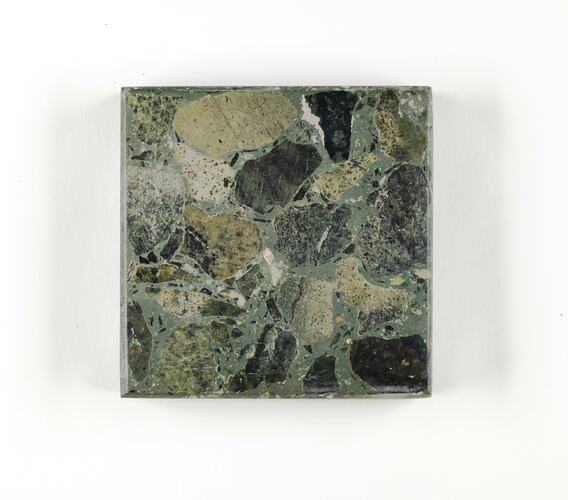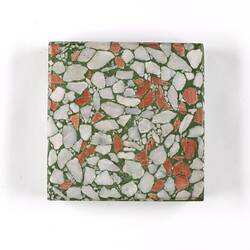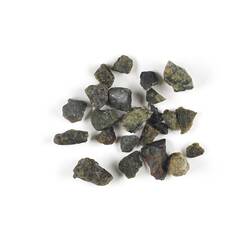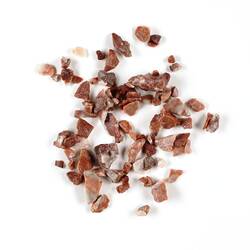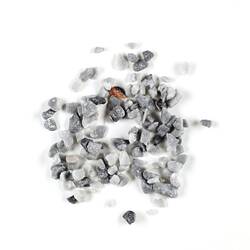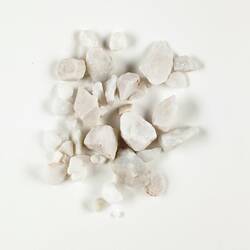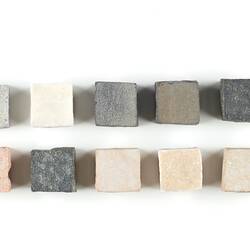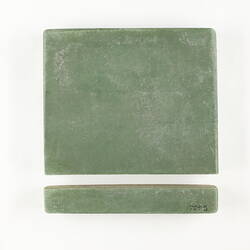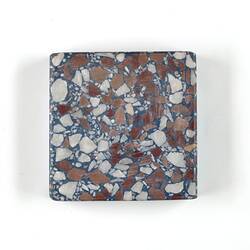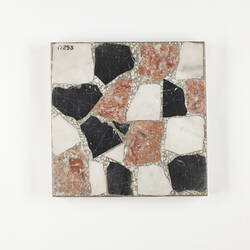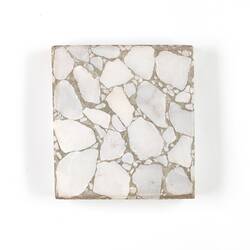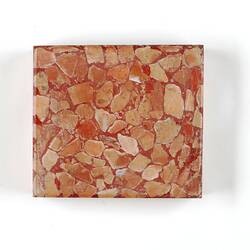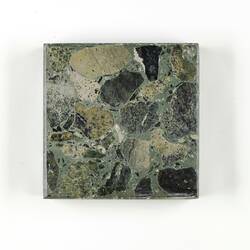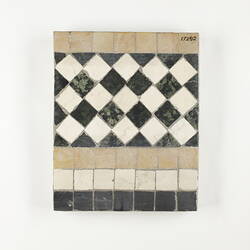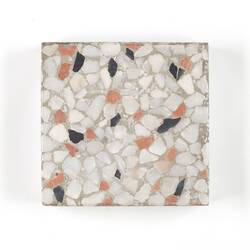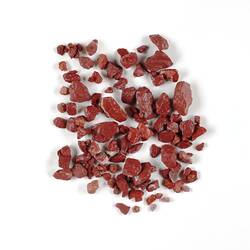Summary
Italian brothers Annibale and Severino De Marco migrated to Australia in the early 1900's from Italy via England. Together they established a successful mosaic and terrazzo business in Melbourne. Few details of their personal lives are on record; however their terrazo and mosaic work is still in place throughout Australia.
Early Life & Terrazo Training
Severino De Marco was one of six children born to Zaccaria and Teresa De Marco (née Manarin) in Fanna, a small province of Pordenone in the Italian region Friuli-Venezia Giulia. Zaccaria was a miner and Teresa was his second wife, three of their six children died in infancy. Zaccaria married Teresa following the death of his first wife Marguarita, with whom he'd had three children. Severino, along with his brother Annibale, was to become a pre-eminent terrazzo and mosaic worker in Melbourne with their business De Marco Brothers Terrazzo Granolithic and Concrete, established circa 1914.
Severino De Marco was born on the 23rd March, 1894, and followed his brother Annibale to England, circa 1907. During this seven years in England, he studied at a premier mosaic school in London, where he gained professional experience on some high profile projects such as the South Kensington Museum and St Paul's Cathedral. This work would later help him secure an important contract for the De Marco Brothers business in Australia during the Depression years.
Arrival in Australia
It wasn't until just prior to the start of World War I that Severino reunited with his brother in Melbourne, arriving on the SS Wiltshire from Liverpool on the 28th of August, 1914. Though originally intending to join his brother in business Severino spent two years working in the Queensland Canefields to escape Italian Military Service, returning to Melbourne in 1916.
In 1920 Severino married Stella Contance De Marco (née Ulmer), an Australian girl. According to notes in Severino's naturalisation papers, his intentions to marry her and settle down in Australia were his primary reasons for applying for citizenship. This was granted on the 3rd of May, 1920. They did not have any children.
For many years, the brothers resided relatively close to each other in the suburbs of Fitzroy and North Fitzroy: Severino in a small single story terrace house at 138 Gore Street, Fitzroy and Annibale lived at 192 Scotchmer Street, North Fitzroy in a modest sized semi-detached property. Both suburbs were very much working class areas at the time, Fitzroy in particular was surrounded by many factories and industrial sites. North Fitzroy was slightly more affluent with larger homes on bigger blocks and wider tree-lined streets.
Community Involvement
Of the brothers, it could be argued that Severino was the more exuberant of the two. Several photographs from the Italian Historical Society show him at social gatherings with friends or partaking in events at the Circolo Italiano Cavour (Italian Cavour Club), a popular Italian social club located in South Melbourne - of which he was President. He is pictured in a 1936 performance with his nephews Dom and Zac at Cavour Club titled Alla Corte di Addis Abbeba, written by fellow club member, Dr Soccorso Santor. The show was a fundraising event for the Italian Red Cross. It is probable that Severino is also pictured attending the 1925 Annual Italian Community Melbourne Hospital Appeal Ball, organised by Cavour Club. In the photograph, a 'Mr and Mrs De Marco' are noted as attendees, although no first initials are listed. While it may have been Annibale - for he too was involved with Cavour Club - Severino was renowned for his charitable contributions, particularly to hospital charities. In fact, Severino eventually became Life Governor of the Children's Hospital, Melbourne Hospital and St. Vincent's Hospital, making it likely that it was he, and not his brother - at the ball.
In 1939, Severino De Marco tried his hand at politics, running for election to the Beaconsfield Ward of the South Melbourne City Council. The De Marco Brothers terrazzo business had operated from South Melbourne since 1936 and Severino chose to run as 'The Local and Progressive Business Candidate.' During his election campaign he drew attention to his charitable associations as well as his role as a senior partner with The De Marco Brothers, commenting on the above average wages he paid his employees. On polling day however, Severino was unsuccessful, losing to the endorsed Labor candidate, Keith Sutton (P.K Sutton), who held the post for fourteen years before becoming Mayor. It is unknown exactly why Severino's campaign failed - perhaps he just wasn't very popular - but it is possible that growing tensions between Australians and Italians due to Italy siding with Germany in World War II, may have contributed to his election loss. While Severino was officially an Australian citizen, there was much suspicion of anyone originating from a country at war with Australia; many foreign residents holding papers from an enemy country were interned as 'enemy aliens' and relocated to internment camps in regional Victoria or in other camps around Australia.
Winding up of De Marco Bros
Severino continued the family business into the 1950's before the company was bought out by Sydney based Melocco Brothers. His last known work on behalf of the De Marco name was on the Australian War Memorial's Hall of Memory. Severino died circa 1961, aged 67, survived by his wife Stella, who died in 1975. They are laid to rest together in the St Kilda Cemetery.
References
Information provided by Dominic de Marco, 2012
Co.As.It. - Italian Historical Society Photographic Collection, record number P-04221, 1936 Performance of 'Alla Corte di Addis Abbeba' , a play written by Doctor Soccorso Santoro, about the life of Haile Selassie
Co.As.It. - Italian Historical Society Photographic Collection, record number P-05293, c1925 The annual Italian community Melbourne Hospital Appeal Ball organised by and held at the Circolo Italiano Cavour [Cavour Club], 170 Cecil Street South Melbourne
Co.As.It. - Italian Historical Society Photographic Collection, record number P-07134, c1912 Female members of the Amerena family just before their departure from Viggiano, Basilicata to Australia
Google Maps - Street view
National Archives of Australia, series A1, control symbol 1923/7963, A Annibale De Marco
Naturalisation National Archives of Australia, series A1, control symbol 1920/4735, Severino De Marco - Naturalisation
National Archives of Australia, series B883, control symbol VX103311, DE MARCO DOMINIC JOHN : Service Number - VX103311 : Date of birth - 01 Dec 1919 : Place of birth - MELBOURNE VIC : Place of enlistment - Unknown : Next of Kin - DE MARCO JESSICA
National Archives of Australia, series B884, control symbol V90139, DEMARCO ZACCARIAH : Service Number - V90139 : Date of birth - 06 Jul 1918 : Place of birth - MIDDLE PARK VIC : Place of enlistment - RIPPONLEA : Next of Kin - DEMARCO A
National Library of Australia 1941 'Advertising.', The Argus (Melbourne, Vic. : 1848 - 1956), 3 March, p. 7, retrieved 10 July, 2012, http://nla.gov.au/nla.news-article8161549
National Library of Australia 1946 '"The Argus" Fund For Children's Hospital, £9,047.', The Argus (Melbourne, Vic. : 1848 - 1956), 20 April, p. 3, retrieved 10 July, 2012, http://nla.gov.au/nla.news-article22255470
National Library of Australia 1946 'More Playgrounds Needed For Children.', The Argus (Melbourne, Vic. : 1848 - 1956), 19 December, p. 2, viewed 10 July, 2012, http://nla.gov.au/nla.news-article22394640
National Library of Australia 1947 'Donations to Red Cross July Appeal.', The Argus (Melbourne, Vic. : 1848 - 1956), 17 July, p. 4, retrieved 10 July, 2012, http://nla.gov.au/nla.news-article22449297 Port Phillip Library Service
Victorian Registry of Births Deaths and Marriages
More Information
-
Keywords
Terrazzo, migrants, Italian Immigration, Italian Communities, Terrazzo Work, Working Life, Family Businesses, Immigration, Migration & Settlement
-
Authors
-
Article types
